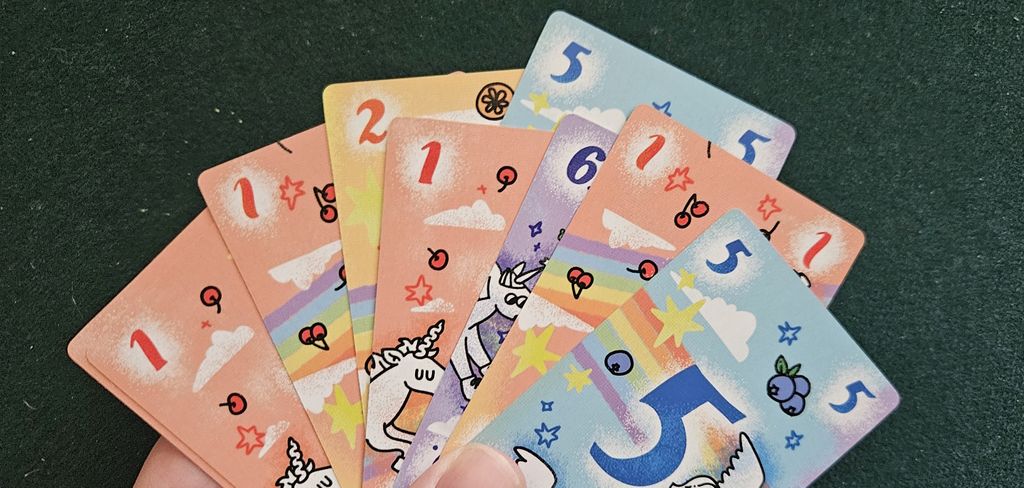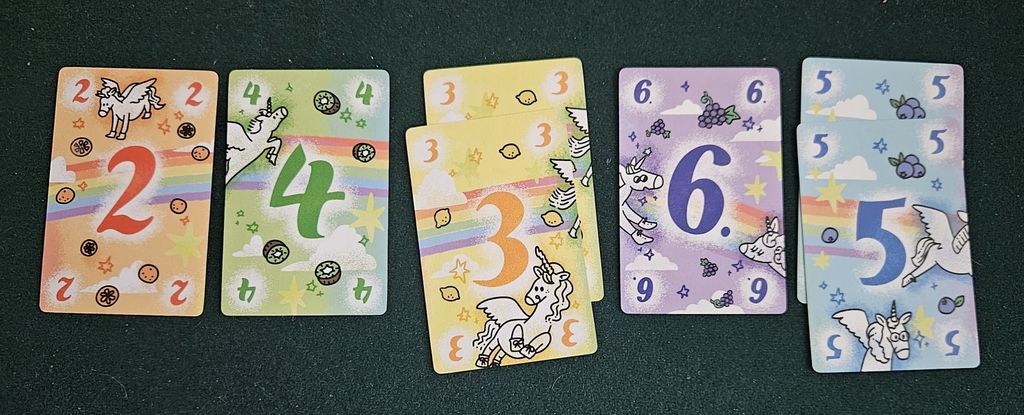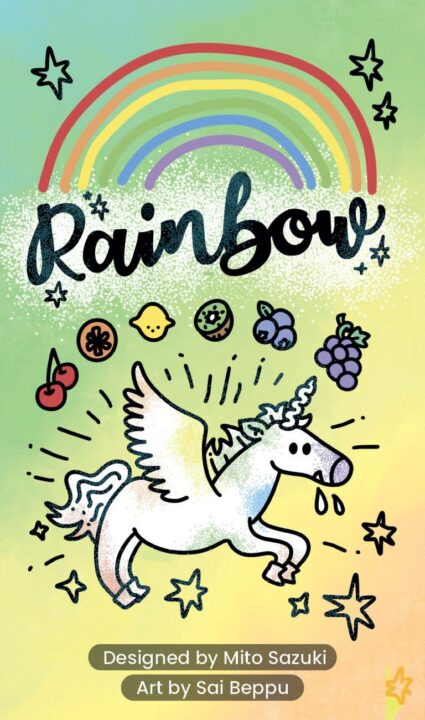If you’ve ever wanted an excuse to argue about colours with your friends, get cozy! This is my review of Rainbow—the board game that had my group laughing, plotting, and occasionally grumbling about our terrible luck. Over a handful of plays, we’ve tested its quirky art, poked at its card quality, and tried to figure out if winning takes skill or just hoping the rainbow gods smile on you. Ready to see if Rainbow belongs on your game shelf, or if it’s just a pretty face? Let’s get into it!
How It Plays
Setting up
Shuffle the colorful deck and deal a handful of cards to each player. Put the rest face down as the draw pile right in the middle of the table. Make sure everyone can reach it, even your cousin with T-Rex arms.
Gameplay
On your turn, lay down cards to build your rainbow, making sure you follow the color order. If you don’t have the one you need, draw from the pile and cross your fingers. The trick is to watch what colors your opponents are collecting, so you can mess with their plans (politely, of course).
Winning the game
The first player to complete their full rainbow shouts, “Taste the rainbow!” (optional) and wins! Everyone else can stare in envy or play again for sweet, sweet revenge.
Want to know more? Read our extensive strategy guide for Rainbow.
Gameplay Flow and Player Interaction in Rainbow
If there’s one thing my board game group loves, it’s a game that keeps us all in the mix, egging each other on and yelling at the table. Rainbow absolutely nails this. The gameplay moves quick—none of that endless waiting for Dave to “just think for a sec.” Turns shoot by, and the rules are simple enough that even my friend who once tried to eat a pawn picked it up in minutes.
Each round, players draw cards and work to collect a set of all seven rainbow colors. The kicker? Everyone can see what colors you have, and you can only take from the visible stack or from your neighbors’ discards. I tell you, nothing gets people riled up like someone snatching the Indigo card you absolutely needed (yes, Sam, I’m still bitter).
The player interaction is spicy. You have to watch everyone, keep track of who’s close to a full set, and sometimes dump a card you know someone else wants. There’s a bit of bluffing, a smidge of risk, and plenty of light-hearted trash talk. I once yelled “Taste my ROYGBIV” and instantly regretted it when the table targeted me for the next three rounds.
Rainbow keeps things light and snappy but makes sure everyone feels involved, every turn. Nobody zones out, and you’ll laugh, groan, and glare at your rivals in equal measure. Speaking of groaning, next up I’ll tackle how much luck and how much strategy actually decide who grabs the pot of gold at the finish line.

Luck vs Strategy: Can You Actually Plan Your Rainbow?
Let’s be honest—nobody likes a board game that’s basically just rolling dice and hoping the gods of chance treat you kindly. If I wanted to spend my evening flipping coins, I’d just raid my couch for lunch money. So when my friends and I sat down to play Rainbow, I was honestly a bit wary. Colorful cards, simple rules—usually this means the luck monster is lurking nearby.
But you know what? Rainbow surprised me a bit. The game starts off looking like it’s all about luck—draw a card, play a card, cross your fingers. But soon, you realize there’s a sneaky amount of strategy swirling in those bright colors. Timing is huge. Should you block Dave from finishing his rainbow just to spite him? (Yes, always.) Or do you risk building your own perfect set? You keep watch on what colors your friends are collecting, and sometimes—if you’re feeling bold—you can totally mess up their plans. It’s a clever dance of risk, memory, and reading your opponents.
Still, I won’t lie. Lady Luck sometimes crashes the party, spills juice all over your careful planning, and leaves you with a handful of useless cards. There are moments where the draw pile just hates you, and that’s that. But for the most part, Rainbow gives a nice balance between luck and player choice. Just don’t expect chess-level brain burning.
Coming up next: get ready for some juicy details about Rainbow’s component quality and artwork. Paintbrushes not included!

Colorful Components and Art: Rainbow’s Visual Appeal
I’ve seen more than my fair share of board games with dull card stock and art that looks like it was done in Microsoft Paint. Thankfully, Rainbow does not fall into that trap. The cards feel thick and pleasant, so you won’t be accidentally turning your game of Rainbow into confetti if your little sister gets excited. I’ve played games where the corners fray faster than my patience during slow turns, but these cards have survived a few sessions in my group—and we play with a guy who thinks shuffling is a contact sport.
Now, let’s talk about the artwork. Rainbow lives up to its name: the colors pop! The hues are bright and happy, almost like the inside of a unicorn’s dream. Each card is easy to tell apart (unless, like my friend Steve, you forget what green looks like). There’s a playful style to the illustrations that makes it feel very friendly for families, but not so childish that adults feel silly playing. I am a grown adult (on paper), and even I was charmed by the way everything looks laid out on the table.
If you are the sort of person who cares about how your game shelves look, you’ll like how Rainbow fits in. The box is sturdy and small enough not to take up the entire shelf, but still big enough to show off that bright cover. Up next, I’ll tell you if playing with different groups makes Rainbow sparkle or fizzle—so stay tuned!
Replay Value: How Many Rainbows Can You Chase?
When my friends first played Rainbow, we thought, “Okay, this is cute. We’ll play it once, then toss it on the shelf with the other games that gather dust.” Boy, were we wrong. A couple of rounds in, and we were giggling, accusing each other of sabotaging rainbows, and plotting our next moves. Rainbow has this sneaky way of making you want to play, again and again, especially with different groups.
For families, Rainbow works like a charm. It’s simple enough for kids to play, but there’s just enough plotting to keep the adults interested too. I tried it with my niece and nephew, and I swear, I caught my brother trying to outwit a seven-year-old. Spoiler: the seven-year-old won. It’s one of those games where everyone actually wants a rematch, even after losing. Sometimes especially after losing.
With gamer friends, Rainbow turns into a whole new beast. Suddenly, every card choice feels like it could make or break your rainbow dreams. Trash talk levels go up, alliances are made and broken in seconds, and everyone’s got a theory on the best way to play. It gets competitive, but it stays light-hearted. No one leaves the table grumpy—that’s a bigger victory than any rainbow.
But does Rainbow survive with every crowd? I’ll say this: if you want a game you can pull out for almost any group, Rainbow is a safe bet. It’s not going to blow anyone’s mind, but it won’t wear out its welcome either. Recommended for groups who like fun and colours over hours of rule-lawyering.
Conclusion
That wraps up my review of Rainbow. If you want a fast, colourful card game that gets everyone talking (or yelling, depending on your friends), it’s a solid pick. It looks good on the table, the cards feel nice, and the rules are simple enough for your grandma but still interesting for your most competitive buddy. Just know that luck can rain on your parade, especially if you think you’re some kind of Rainbow mastermind! Still, for quick, lively fun, Rainbow will brighten your game shelf. Now if you’ll excuse me, I have to go teach my neighbour that purple does, in fact, beat red. Good luck, and happy gaming!


